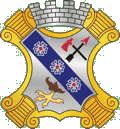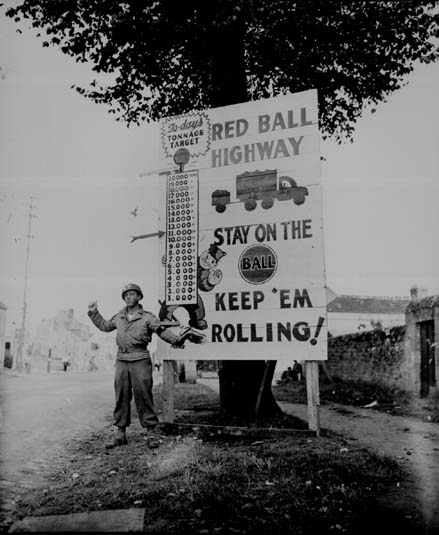(4TH INFANTRY DIVISION) IN THE HURTGEN FOREST,
GERMANY, 16-22 NOVEMBER 1944
(RHINELAND CAMPAIGN)
By Lieutenant Colonel James W. Haley

INTRODUCTION
The Battle of the Hurtgen forest, Germany, which took place in November and December of 1944, will undoubtedly take its place in history along side such epic encounters as those that occurred in the Battle of The Wilderness in the War between the States and the Battle of the Argonne Forest in World War I. First Lieutenant Bernard F, Ray, Company F, 8th Infantry, was awarded the Congressional Medal of Honor, posthumously, for his action in the assault of the 2nd Battalion, 8th Infantry, against the prepared positions of the Germans in this forest on 17 November 1944. Two days later on 19 November 1944, Lieutenant Colonel George L, Mabry, Jr. (then Major), Commanding Officer, 2nd Battalion, 8th Infantry, personally led the Battalion in extremely difficult fighting in such a manner that he too was awarded the Congressional Medal of Honor.
This historical account will deal with the action of the 2nd Battalion, 8th Infantry, 4th Infantry Division, during the period 16-22 November, 1944 in the Hurtgen Forest. Between 1245 hours on 16 November 1944 and dark of that same day this battalion, a veteran combat unit which had led the assault on Utah Beach in Normandy on 6 June 1944, had lost approximately 135 officers and enlisted men, killed or wounded. These figures, together with the examples of courage and leadership listed in the above paragraph, will give the reader an indication of the type of resistance encountered in the cold, damp Hurtgen Forest. The fact that this attack was finally successful, although every foot of ground was stubbornly contested, is a monument to the leadership and courage of the officers and grim determination and fortitude of the soldiers of the united States Army.
In order to orient the reader for this operation it is necessary to go back to the Battle of France. With the defeat in Normandy the Germans had suffered severe losses in both men and material. These losses continued to grow throughout the withdrawal across France and Belgium. The Seventh German Army had suffered the brunt of the defeat in Normandy but its withdrawal, although greatly hampered by the constant air and ground attacks of the Allied Forces, was a planned withdrawal and was as orderly as possible under the existing conditions. The Fifteenth German Army, which was disposed along the coast in the Calais area of France, continued to hold the Scheldt Estuary on 15 September 1944 even though most of its armor had been withdrawn. The intent here was to deny the Allies the use of the great port of Antwerp, Belgium. In order to slow the advance of the Allies and to cover the withdrawals, the Fifth German Panzer Army had been moved into France and Belgium and successfully accomplished its mission, especially on the northern flank. 1
The withdrawing German Armies were closely pursued and by the middle of September 1944 the Allied Armies were disposed along the German border facing the Siegfried line. The vaunted line had actually been penetrated in two places without too much difficulty — in the Schnee Eifel Forest east of St. Vith, Belgium and in the Hurtgen Forest southeast of Aachen, Germany. (See Map B) However, even though enemy resistance was relatively light, it became necessary to halt the advance. This halt was necessitated by two factors. First, the supply lines were greatly over-extended; the advance had been so rapid that the supply installations could not maintain the pace. Secondly, the units along the front were greatly over-extended and there were wide gaps between the front line divisions. Many commanders at this, time thought that the end of the war was in sight and the morale of thy troops was of the highest order. However, the only alternative was to halt, consolidate and re-supply. 2
German losses in France had been great. Their casualties, including killed, wounded and captured had reached one million men by the end of September 1944. This total included the losses of the First German Army to the Sixth United States Army Group in the Southern France Campaign. However, the enemy's will to resist had not been destroyed. Rather, it was strengthened by the knowledge that he was now fighting on the soil of his homeland. He was desperately in need of an opportunity to reorganize and re-equip and our poor logistical situation, together with the poor weather conditions of this period, gave him that disadvantage. 3
 Even though the difficulties were great, the Allies made some gains during October 1944. After several weeks of fierce resistance by the Germans and determined attacks by the Allies, Aachen was captured by units of VII United States Corps on 21 October. This was the first large German city to fall but fighting here was to characterize the determined resistance to be later encountered in this area. A foothold was gained in the city of Stolberg during the period but nowhere along the front could a major operation be mounted. (See Map B) 4
Even though the difficulties were great, the Allies made some gains during October 1944. After several weeks of fierce resistance by the Germans and determined attacks by the Allies, Aachen was captured by units of VII United States Corps on 21 October. This was the first large German city to fall but fighting here was to characterize the determined resistance to be later encountered in this area. A foothold was gained in the city of Stolberg during the period but nowhere along the front could a major operation be mounted. (See Map B) 4
By 22 October 1944 the supply situation of the First United States Army had eased somewhat. Railheads had been pushed forward and the "Red Ball" highway had been in operation for some time. It now began to appear that the logistical situation would be able to sustain a major offensive. The zone of action of the First United States Army at this time extended from Aachen, Germany on the north, south generally along the German border to a junction with the Third United States Army where the French, German and Luxembourg borders intersect. (See Map B) 5
The Allied High Command had not been idle during the buildup period. In spite of the opinions of many military experts that a major offensive during winter is impossible, plans were laid for just such an operation. The "big picture" strategy was to strike at the important industrial areas of Germany, the Ruhr and the Saar, thereby forcing the German High Command to commit its General Reserve. This would afford the Allies the opportunity to destroy this reserve, to overrun Germany proper and thus to end the war in Europe. In support of this strategy, the First United States Army and the Third United States Army were to advance eastward to the Rhine River. Then the Ninth United States Army and the British Second Army were to attack to the north. The major attack was to be made along the front from Roermond on the north to a point about ten miles south of Aachen. In this attack the First United States Army was to make the main effort on its left. Seven Corps, three British and two of the Ninth United States Army and the VII and V Corps of the United States First Army, were to make a coordinated attack early in November 1944. 6

